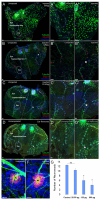Sponge bHLH Gene Expression in Xenopus laevis Disrupts Inner Ear and Lateral Line Neurosensory Development and Otic Afferent Pathfinding
- PMID: 40564948
- PMCID: PMC12193494
- DOI: 10.3390/ijms26125487
Sponge bHLH Gene Expression in Xenopus laevis Disrupts Inner Ear and Lateral Line Neurosensory Development and Otic Afferent Pathfinding
Abstract
Basic helix-loop-helix (bHLH) transcription factors, such as those in the atonal family, are important in cellular fate determination. The expression of the sponge ortholog of the atonal bHLH gene family, AmqbHLH1, in Xenopus laevis previously resulted in the formation of ectodermal ectopic neurons. However, the extent to which these neurons persist through development and the effects on the inner ear and lateral line, which require a critical level and timing of bHLH genes, remains unexplored. To test these long-term effects, we injected various concentrations of AmqbHLH1 mRNA into X. laevis embryos and assessed neurosensory development at developmental stages coinciding with fully developed neurosensory structures. The expression of AmqbHLH1 mRNA in X. laevis resulted in a dose-dependent reduction in or loss of ears and the lateral line system without eliminating ectopic neurons. At the lowest concentrations examined, we found that inner ear neurosensory development consisted sometimes of only a few scattered hair cells in a single-layer epithelium. Furthermore, low concentrations of AmqbHLH1 mRNA affected inner ear afferent guidance. Our data suggest that the AmqbHLH1 gene has some anti-neurosensory abilities in frogs and that the overexpression of a single gene may not be sufficient for stable long-term transdifferentiation in cells.
Keywords: Neurod1; atonal; bHLH; inner ear; lateral line; neurosensory development.
Conflict of interest statement
The authors declare no conflict of interest.
Figures





Similar articles
-
Combined Atoh1 and Neurod1 Deletion Reveals Autonomous Growth of Auditory Nerve Fibers.Mol Neurobiol. 2020 Dec;57(12):5307-5323. doi: 10.1007/s12035-020-02092-0. Epub 2020 Sep 3. Mol Neurobiol. 2020. PMID: 32880858 Free PMC article.
-
Differential requirement of Hand1 during differentiation of lateral plate mesoderm lineages in Xenopus laevis.Dev Biol. 2025 Sep;525:294-305. doi: 10.1016/j.ydbio.2025.06.005. Epub 2025 Jun 14. Dev Biol. 2025. PMID: 40523515
-
Early Deletion of Neurod1 Alters Neuronal Lineage Potential and Diminishes Neurogenesis in the Inner Ear.Front Cell Dev Biol. 2022 Feb 17;10:845461. doi: 10.3389/fcell.2022.845461. eCollection 2022. Front Cell Dev Biol. 2022. PMID: 35252209 Free PMC article.
-
Maternal and neonatal outcomes of elective induction of labor.Evid Rep Technol Assess (Full Rep). 2009 Mar;(176):1-257. Evid Rep Technol Assess (Full Rep). 2009. PMID: 19408970 Free PMC article.
-
Interventions for acute otitis externa.Cochrane Database Syst Rev. 2010 Jan 20;(1):CD004740. doi: 10.1002/14651858.CD004740.pub2. Cochrane Database Syst Rev. 2010. PMID: 20091565
References
-
- Butts J.C., Wu S.R., Durham M.A., Dhindsa R.S., Revelli J.P., Ljungberg M.C., Saulnier O., McLaren M.E., Taylor M.D., Zoghbi H.Y. A single-cell transcriptomic map of the developing Atoh1 lineage identifies neural fate decisions and neuronal diversity in the hindbrain. Dev. Cell. 2024;59:2171–2188.e2177. doi: 10.1016/j.devcel.2024.07.007. - DOI - PubMed
MeSH terms
Substances
Grants and funding
LinkOut - more resources
Full Text Sources

